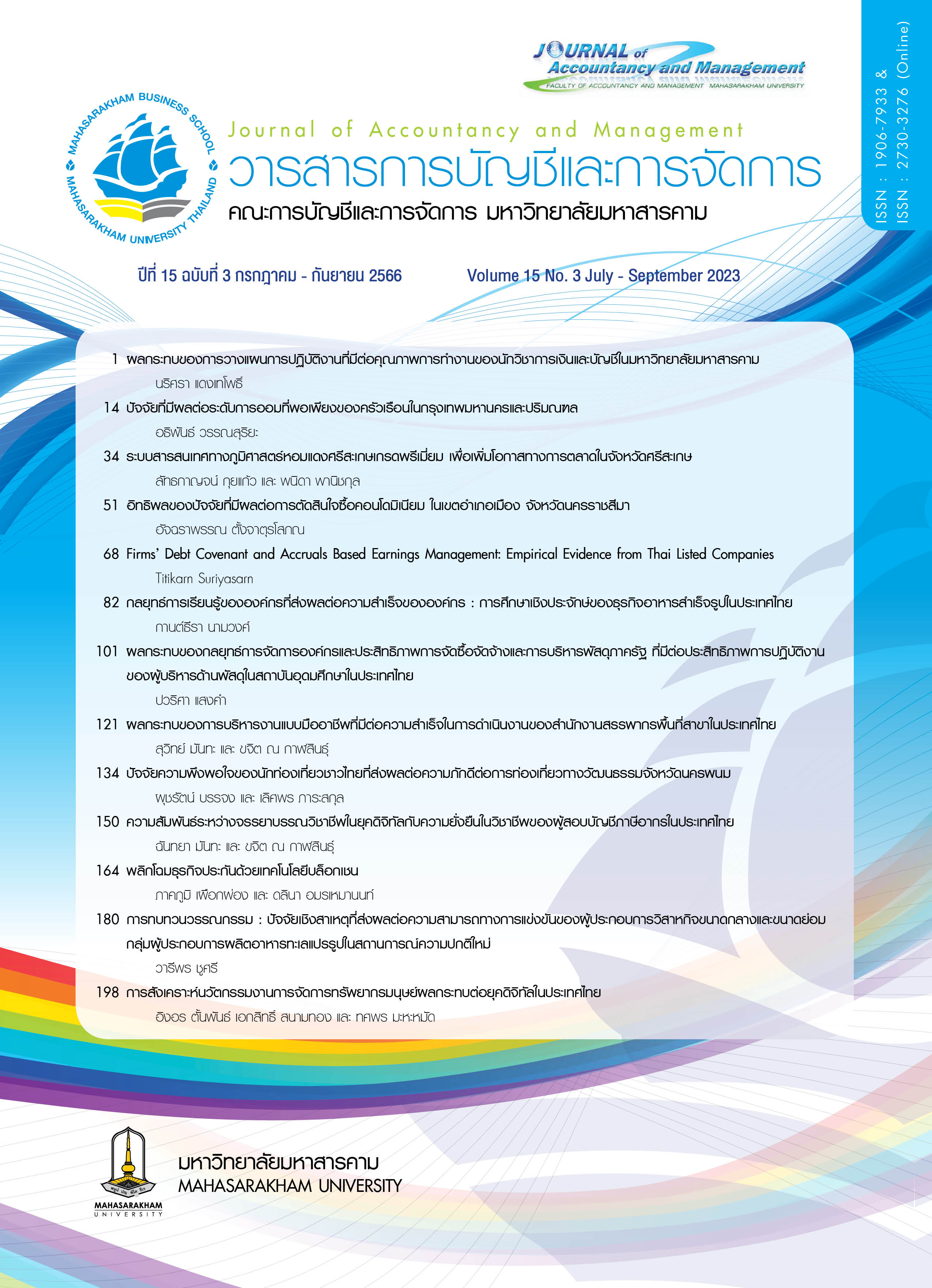การทบทวนวรรณกรรม : ปัจจัยเชิงสาเหตุที่ส่งผลต่อความสามารถทางการแข่งขันของผู้ประกอบการวิสาหกิจขนาดกลางและขนาดย่อม กลุ่มผู้ประกอบการผลิตอาหารทะเลแปรรูปในสถานการณ์ความปกติใหม่
Main Article Content
บทคัดย่อ
บทความวิชาการในครั้งนี้เป็นการทบทวนวรรณกรรมที่เกี่ยวข้องกับปัจจัยที่ส่งผลต่อความสามารถทางการแข่งขันโดยมีวัตถุประสงค์เพื่อพัฒนากรอบแนวคิดของปัจจัยที่ส่งผลต่อความสามารถในการแข่งขันของผู้ประกอบการขนาดกลางและขนาดย่อมในกลุ่มผู้ประกอบการซึ่งผลิตอาหารทะเลแปรรูปในสถานการณ์ความปกติใหม่ โดยใช้การศึกษาและทบทวนวรรณกรรมที่เกี่ยวข้อง และวิเคราะห์เอกสารเพื่อพัฒนาเป็นกรอบแนวคิด ซึ่งผลการศึกษาพบว่า ปัจจัยเชิงสาเหตุ ได้แก่ ภาวะผู้นำการเปลี่ยนแปลง ความสามารถในการปรับตัว ความร่วมมือ มีอิทธิพลต่อความสามารถในการแข่งขันของผู้ประกอบการขนาดกลางและขนาดย่อมในกลุ่มผู้ประกอบการ ซึ่งแนวทางการศึกษาในอนาคตสามารถนำกรอบแนวคิดนี้ไปทดสอบเชิงประจักษ์ในกลุ่มผู้ประกอบการ อันจะนำไปสู่ผลให้ผู้ประกอบการมีความสามารถในการแข่งขัน ซึ่งส่งผลให้ธุรกิจมีความเจริญเติบโตต่อไปในอนาคตได้
Downloads
Article Details

อนุญาตภายใต้เงื่อนไข Creative Commons Attribution-NonCommercial-NoDerivatives 4.0 International License.
บทความที่ได้รับการตีพิมพ์เป็นลิขสิทธิ์ของวารสารการบัญชีและการจัดการ
ข้อความที่ปรากฏในบทความแต่ละเรื่องในวารสารวิชาการเล่มนี้เป็นความคิดเห็นส่วนตัวของผู้เขียนแต่ละท่านไม่เกี่ยวข้องกับมหาวิทยาลัยมหาสารคาม และคณาจารย์ท่านอื่นๆในมหาวิทยาลัยฯ แต่อย่างใด ความรับผิดชอบองค์ประกอบทั้งหมดของบทความแต่ละเรื่องเป็นของผู้เขียนแต่ละท่าน หากมีความผิดพลาดใดๆ ผู้เขียนแต่ละท่านจะรับผิดชอบบทความของตนเองแต่ผู้เดียว
เอกสารอ้างอิง
กรมประมง. (2565). กรมประมงชี้พิษโควิด-19 ป่วนกระทบธุรกิจประมงไทย. ค้นเมื่อ 26 มิถุนายน 2565, จาก https://m.facebook.com/227334884050780/photos/%E0%B8%81.
ชฎารัฐ ขวัญนา. (2563). ความสัมพันธ์ระหว่าง กลยุทธ์ระดับธุรกิจ กับความสำเร็จของธุรกิจของผู้ประกอบการธุรกิจในเขตภาคตะวันออกเฉียงเหนือตอนบน. วารสารการบัญชีและการจัดการ มหาวิทยาลัยมหาสารคาม, 12(4), 121-133.
ชาญชัย ชัยประสิทธิ์. (2564).เจาะพฤติกรรมผู้บริโภคไทยที่เปลี่ยนไปในยุคโควิด-19. ค้นเมื่อ 12 มกราคม 2565, จาก https://www.pwc.com/th/en/pwc-thailand-blogs/blog-20210518.html.
วิโรจน์ เจษฎาลักษณ์ และ ชนัญชิดา เจริญวัฒ. (2558). ลักษณะการบริโภคสินค้าและบริการของแรงงานต่างด้าวและการปรับตัวของการประกอบการธุรกิจขนาด กลางและขนาดย่อม กรณีศึกษา อำเภอเมือง จังหวัดสมุทรสาคร. Veridian E-Journal, Slipakorn University, 8(2), 1102-1113.
ทำนอง ชิดชอบ และ นลิน เพียรทอง. (2561). โมเดลความสัมพันธ์เชิงสาเหตุของแรงผลักดัน การจัดการโซ่อุปทานสีเขียวและผลการดำเนินธุรกิจขออุตสาหกรรมการผลิตในประเทศไทย : การทบทวนวรรณกรรม. วารสารการจัดการสมัยใหม่, 16(2), 127-140.
นวิทย์ เอมเอก. (2557). ปัจจัยที่ส่งผลต่อสมรรถนะเชิงพฤติกรรมเพื่อความสามารถในการแข่งขัน และความสำเร็จในการประกอบการของผู้ประกอบการการค้าชายแดนไทย-มาเลเซีย เพื่อรองรับประชาคมเศรษฐกิจอาเซียน. วารสารราชภัฏสุราษฎร์ธานี, 1(1), 245-257.
ประไพทิพย์ ลือพงษ์. (2556). การพัฒนาทุนมนุษย์ให้มี สมรรถนะความสามารถในการแข่งขัน. วารสารนักบริหาร, 32(4), 103-109.
แพรลฎา พจนารถ และ กฤษดา เชียรวัฒนสุข. (2563). ภาวะผู้นำเชิงนวัตกรรมเพื่อความได้เปรียบในการแข่งขันขององค์การในศตวรรษที่ 21. วารสารการจัดการปริทัศน์, 22(1), 241-257.
วิจัยกรุงศรี. (2565). แนวโน้มธุรกิจอุตสาหกรรม ปี 2562-2564: อุตสาหกรรมอาหารทะเลแปรรูป. ค้นเมื่อ 12 มกราคม 2565, จาก https://www.krungsri.com/th/research/industry/industry-outlook/Food-Beverage/Processed-Seafood/IO/io-frocessed-seafood-20-th.
สุภาวดี สุทธิรักษ์ และ สมนึก เลิศแก้ว. (2563). แบบจำลองสมการโครงสร้างปัจจัยที่มีอิทธิพลต่อผลการดำเนินงานของกลุ่มวิสาหกิจชุมชน. วารสารสังคมศาสตร์และมานุษยวิทยาเชิงพุทธ, 6(8), 432-447.
สำนักงานส่งเสริมวิสาหกิจขนาดกลางและขนาดย่อม. (2564). บทสรุปผู้บริหารรายงานสถานการณ์วิสาหกิจขนาดกลางและขนาดย่อม. ค้นเมื่อ 11 มกราคม 2565, จาก https://www.sme.go.th/upload/mod_download/download-20210922171225.pdf
Avolio, B. J., Bass, B. M., & Jung, D. I. (1999). Reexamining the components of transformational and transactional leadership using the multifactor leadership. Journal of occupational and Organizational Psychology, 72(4), 441-462.
BarNir, A., & Smith, K. A. (2002). Interfirm Alliances in the Small Business : The Role of Social Network. Journal of Small Business Management, 40(3), 219–232.
Barney, J. B. (1991). Firm resources and sustainable competitive advantage. Journal of Management, 17(1), 99- 120.
Bennis, W., & Nanus, B. (1985). Leadership: The strategies for taking charge. New York : Harper Paperbacks
Boyer, K., & Lewis, M. (2002). Competitive Priorities: Investigating the Need for Trade-Offs in Operations Strategy. Journal of Production and Operations Management, 11(1), 9-20.
Buckley, P. J., Pass, C. L., & Prescott, K. (1998). Foreign market servicing strategies and competitiveness. Journal of General Management, 17(2), 34–46.
Chakravarthy, B. S. (1982). Adaptation: A Promising Metaphor for Strategic Management. The Academy of Management Review, 7(1), 35-44.
Cooper, R. (2017). Supply chain development for the lean enterprise : interorganizational cost management. London : Routledge.
Dobrivojevic, G. (2013). Analysis of the competitive environment of tourist destinations aiming at attracting FDI by applying Porter’s Five Forces Model. British Journal of Economics, Management and Trade, 3(4), 359-371.
Evangelista, P., & Sweeney, E. (2006). Technology usage in the supply chain: The case of small 3PLs. International Journal of Logistics Management, 17(1), 55-74.
Faems, D., Looy, B. V., & Debackere, K. (2005). Interorganization collaboration and innovation: toward a portfolio approach. Journal of Product Innovation Management, 22(3), 238-250.
Fang, E. (2008). Customer participation and the trade-off between new product innovativeness and speed to market. Journal of Marketing, 72(4), 90-104.
Gruner, K. E., & Homburg, C. (2000). Does customer interaction enhance new product success. Journal of Business Research, 49(1), 1-14.
Hanna, V., & Walsh, K. (2002). Small Firm Networks : A Successful Approach to Innovation. R & D Management, 32(2), 201–207.
Huang, K., Dyerson, R., Wu, L., & Harindranath, G. (2015). From Temporary Competitive Advantage to Sustainable Competitive Advantage. British Journal Management, 25(4), 617-636.
Hunt, S. D. (2002). Marketing and a general theory of competition. Journal of Marketing Management, 18(1), 239-247.
James, M. B. (2010). Leadership. New York: Harper Perennial Modern Classics (1st ed.). Boston : Pearson Education.
Koufteros, X., Vonderembse M, A., & Doll, J. (2002). Examining the Competitive Capabilities of Manufacturing Firms. Structural Equation Modeling: A Multidisciplinary Journal, 9(2), 256-282.
Lin, H., Su, J., & Higgins, A. (2015). How dynamic capabilities affect adoption of management innovation. Retrieved on November 21, 2021, from: http://www.sciencedirect. com/science/article/
Luthans, F. (1998). Organizational Behaviour. (8th ed.). New York : Irwin-McGraw-Hill.
Lusch, R. F., Vargo, S. L., & O’Brien, M. (2007). Competing through service: insights from service-dominant logic. Journal of Retailing, 83(1), 5-18.
McKee, D. O., Varadarajan, P. R., & Pride, W. M. (1989). Strategic adaptability and firm performance: A market-contingent perspective. Journal of Marketing, 53(3), 21- 3.
McShane, S. L., & Von Glinow, M. A. (2000). Organizational Behavior. New York : America.
Michael, S., & Mekoth, N. K. (2012). A typology for frontline employee adaptability to gain insights in service customization: a viewpoint. International Journal of Services and Operations Management, 12(4), 490-508.
Najib, M., Dewi, F. R., & Widyastuti, H. (2014). Collaborative Networks as a Source of Innovation and Sustainable Competitiveness for Small and Medium Food Processing Enterprises in Indonesia. International Journal of Business and Management, 9(9), 146-160.
Paul, M. M. (1997). Psychology Applied to Work An Introduction to Industrial and Organization Psychology. (5th ed.) California : Brooks/Cole.
Piatkowski, M. (2012). Factors Strengthening the Competitive Position of SME Sector Enterprises. An Example for Poland. Procedia - Social and Behavioral Sciences, 58(1), 269 – 278.
Porter, M. E. (1990). The Competitive Advantage of Nations. London : Macmillan.
Porter, M. E. (1998). Cluster and the New Economics of Competition. Retrieved on November 10, 2021, from http://www.wellbeingcluster.at/.
Rindova, V. P., & Kotha, S. (2001). Continuous Morphing : Competing through Dynamic Capabilities, Form, and Function. Academy of Management Journal, 44(1), 1263-1280.
Robbins, S. P., & Coulter, M. (2005). Management. (8th ed.). Upper Saddle River : Prentice Hall.
Schultz, D. P., & Schyltz, S. E. (1998). Psychology and Work Today: An Introduction Industrial and Organizational Psychology. (7th ed.). New Jersey : Prentice- Hall, Inc.
Verma, R., & Jayasimha, K. R. (2014). Service delivery innovation architecture : An empirical study of antecedents and outcomes. IIMB Management Review, 26, 105-121.
Waldman, D. A., Siegel, D. S., & Javidan, M. (2006). Components of CEO transformational leadership and corporate social responsibility. Journal of Management Studies, 43(8), 1703-1725
Wernerfelt, B. (1984). Consumers with differing reaction speeds, scale advantages and industry structure. Journal of European Economic Review, 24(2), 257-270.
Yáñez-Araque, B., Hernández-Perlines, F., & Moreno-Garcia, J. (2017). From training to organizational behavior: A mediation model through absorptive and innovative capacities. Frontiers in Psychology, 8(1), 1532-1545.
Zeng, S. X., Xie, X. M., & Tam, C. M. (2010). Relationship between Cooperation Network and Innovation Performance of SMEs. Technovation, 30(1), 181–194.


